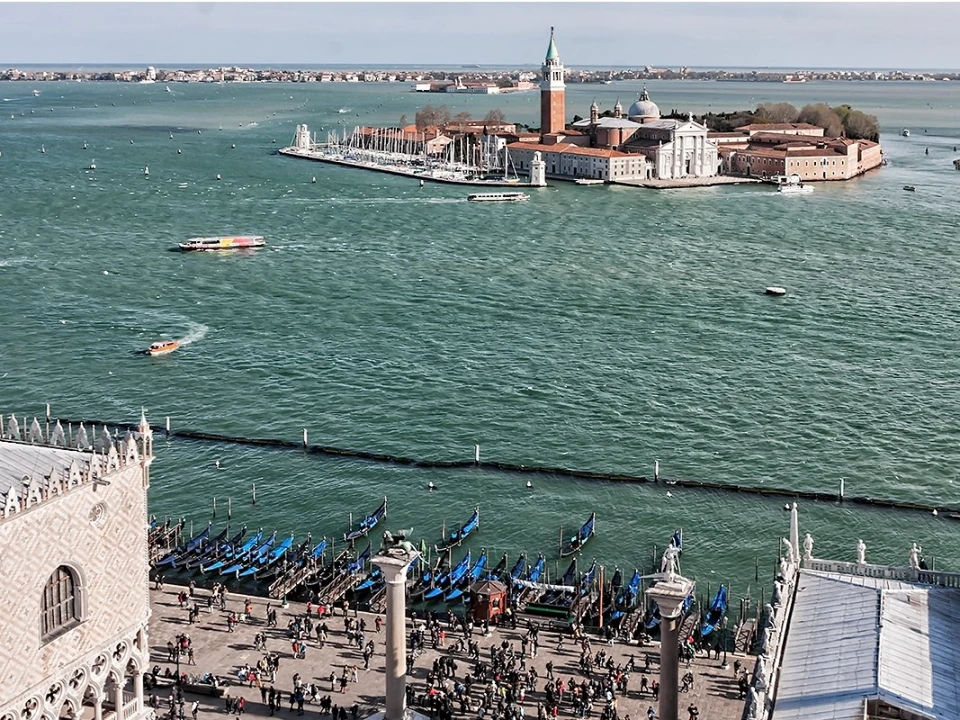Elegant, inimitable, exciting and romantic, precious: this is Venice, the gem on any tour of Italy where churches, palazzi, ancient bridges, monuments and piazzas confirm its artistic and cultural vitality. All has testified to and continues to testify to the long history of the city.
Venice’s beating heart is Piazza San Marco, Europe’s most elegant living room, which is surrounded by works of indisputable mastery and prestige: the imposing Campanile Bell Tower, and the Basilica with its five portals and decorations in marble and mosaics hinting at the pomp and extravagance of the interior; the Palazzo Ducale, symbol of the various golden temples of La Serenissima ("The Most Serene Republic of Venice")); the Moors’ Tower, famously known as the Clock Tower, given the highly-evolved engineering that for centuries has marked the time for Venice; and the Ala Napoleonica housing the Museo Correr.
Several historic cafes yield onto the piazza. Not to be overlooked is the marvelous Caffè Florian: opened in 1720, it is the oldest cafe in Italy. The elegant interiors are remarkable for their use of stucco, their paintings and mirrors. And among the illustrious clientele that sat at Florian’s tables throughout the centuries, Giacomo Casanova, Lord Byron, Ugo Foscolo and Gabriele d’Annunzio must be mentioned.
Not far from Piazza San Marco lies Campo Santo Stefano and the same-named church.
Venice’s campi are historic piazzas, often embellished with central monuments of significance, and dominated by splendid religious buildings, from which the campi often take their name. The streets, rather, are called calli (Italian singular, calle), typical of Venice’s plan in which on both sides of the street, one passes uninterrupted stretches of a single building.
The Venetians say that the best way to know their fantastic city is to take any calle and walk it with your “nose in the air.” That way you can observe everything in front of you without consulting a map, and without missing a beat; don’t be afraid to get lost, as the enchanting paths will always take you back… to Piazza San Marco!
From here, walking over the Bridge of Sighs to enjoy a breathtaking view of the lagoon, one arrives in the Castello sestiere (neighborhood). Castello abounds with architectural and artistic jewels like the Churches of Santa Maria dei Miracoli and of San Zaccaria, and the Church of San Giovanni in Bragora, considered by many to be one of the most beautiful in the city. Continuing a walk through the calli, visitors will come across the not-to-be missed Arsenale, for centuries the largest in the world. Constructed in the 12th Century and then expanded along with the city’s important political and commercial development, today it hosts the Biennales for Art and Architecture.
The Venice Film Festival, on the other hand, runs inside the Palazzo del Cinema on the island known as the Lido.
From Piazza San Marco, the Island of San Giorgio Maggiore and its high tower raised up on the monumental complex are all visible – it is a masterpiece by several important architects, including the highly-esteemed Andrea Palladio. A museum under the sky, it can be seen in all its glory as one sweeps through the waters of the Canal Grande, the city’s main thoroughfare that begins at the triangular Punta della Dogana, the ancient port of this Marine Republic. Exactly four bridges cross the canal: the Ponte dell'Accademia, the Rialto Bridge (the oldest and most famous of the bridges), Ponte degli Scalzi (the Bridge of the Barefoot) and Ponte della Costituzione.
The aforementioned Punta della Dogana is the point at which the Canal Grande and the Canale della Giudecca become one (or separate, depending on your perspective). The Dogana da Mar complex is here and, together with Palazzo Grassi, is the seat of the François Pinault Foundation; these are centers for excellence in the category of Contemporary art, in Italy and internationally.
The Peggy Guggenheim Collection is also a huge must; located inside the Palazzo Venier dei Leoni, it holds important artworks from the 20th Century. Continuing in the same direction, one finds other important museums: the Galleries of the Accademia, inside the majestic complex of the Scuola Grande de la Carità, which also comprises the homonymous church and monastery; and Ca’ Rezzonico, one of the most awe-inspiring palaces from the Renaissance and location for the Museum of 18th Century Venice.
Remaining in the western part of the city, we can see all the sestieri (Venice is divided into these six diverse zones): Cannaregio, Castello, Dorsoduro, San Marco, San Polo, and Santa Croce, which boasts the most famous campi - or piazzas - in the world, the ones framed by fascinating religious structures and elegant noble palaces.
The Venice of 118 Islands
Around Venice itself lie the more than one hundred other islands making up this lagoon city – the predominant ones being Burano, world-famous for its lace; Murano and its glass production; Pellestrina, characterized by sandy dunes and reed groves; and Torcello, one of the oldest human settlements in the area.




